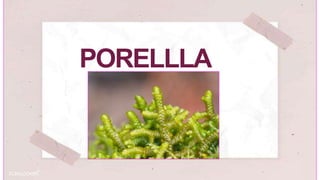Porella : features, morphology, anatomy, reproduction etc.
•Download as PPTX, PDF•
0 likes•65 views
Porella
Report
Share
Report
Share

Recommended
More Related Content
Similar to Porella : features, morphology, anatomy, reproduction etc.
Similar to Porella : features, morphology, anatomy, reproduction etc. (20)
Selaginella: features, morphology ,anatomy and reproduction.

Selaginella: features, morphology ,anatomy and reproduction.
Pteris : features, anatomy, morphology and lifecycle

Pteris : features, anatomy, morphology and lifecycle
Morphology, Structure and Reproduction of Equisetum. 

Morphology, Structure and Reproduction of Equisetum.
Marchantia, Dr.V.Vijaya, Assistant Professor of Botany, E.M.G. Yadava Women's...

Marchantia, Dr.V.Vijaya, Assistant Professor of Botany, E.M.G. Yadava Women's...
PSILOTUM : structure, morphology, anatomy, reproduction , life cycle etc.

PSILOTUM : structure, morphology, anatomy, reproduction , life cycle etc.
More from Cherry
More from Cherry (20)
RETROGRESSIVE CHANGES, CONCEPT OF CLIMAX COMMUNITIES AND RESILIENCE OF COMMU...

RETROGRESSIVE CHANGES, CONCEPT OF CLIMAX COMMUNITIES AND RESILIENCE OF COMMU...
COMMUNITY DYNAMICS CHARACTERISTICS- CYCLIC AND NON-CYCLIC REPLACEMENT CHANGES...

COMMUNITY DYNAMICS CHARACTERISTICS- CYCLIC AND NON-CYCLIC REPLACEMENT CHANGES...
INSERTIONAL INACTIVATION AND COMPLEMENTATION OF DEFINED MUTATION (1).pptx

INSERTIONAL INACTIVATION AND COMPLEMENTATION OF DEFINED MUTATION (1).pptx
Recently uploaded
Recently uploaded (20)
Exomoons & Exorings with the Habitable Worlds Observatory I: On the Detection...

Exomoons & Exorings with the Habitable Worlds Observatory I: On the Detection...
Biochemistry and Biomolecules - Science - 9th Grade by Slidesgo.pptx

Biochemistry and Biomolecules - Science - 9th Grade by Slidesgo.pptx
GBSN - Microbiology (Unit 6) Human and Microbial interaction

GBSN - Microbiology (Unit 6) Human and Microbial interaction
Detectability of Solar Panels as a Technosignature

Detectability of Solar Panels as a Technosignature
mixotrophy in cyanobacteria: a dual nutritional strategy

mixotrophy in cyanobacteria: a dual nutritional strategy
ERTHROPOIESIS: Dr. E. Muralinath & R. Gnana Lahari

ERTHROPOIESIS: Dr. E. Muralinath & R. Gnana Lahari
NuGOweek 2024 full programme - hosted by Ghent University

NuGOweek 2024 full programme - hosted by Ghent University
In-pond Race way systems for Aquaculture (IPRS).pptx

In-pond Race way systems for Aquaculture (IPRS).pptx
Film Coated Tablet and Film Coating raw materials.pdf

Film Coated Tablet and Film Coating raw materials.pdf
WASP-69b’s Escaping Envelope Is Confined to a Tail Extending at Least 7 Rp

WASP-69b’s Escaping Envelope Is Confined to a Tail Extending at Least 7 Rp
Plasmapheresis - Dr. E. Muralinath - Kalyan . C.pptx

Plasmapheresis - Dr. E. Muralinath - Kalyan . C.pptx
GBSN - Biochemistry (Unit 4) Chemistry of Carbohydrates

GBSN - Biochemistry (Unit 4) Chemistry of Carbohydrates
Manganese‐RichSandstonesasanIndicatorofAncientOxic LakeWaterConditionsinGale...

Manganese‐RichSandstonesasanIndicatorofAncientOxic LakeWaterConditionsinGale...
GBSN - Microbiology (Unit 7) Microbiology in Everyday Life

GBSN - Microbiology (Unit 7) Microbiology in Everyday Life
Mining Activity and Investment Opportunity in Myanmar.pptx

Mining Activity and Investment Opportunity in Myanmar.pptx
Constraints on Neutrino Natal Kicks from Black-Hole Binary VFTS 243

Constraints on Neutrino Natal Kicks from Black-Hole Binary VFTS 243
Porella : features, morphology, anatomy, reproduction etc.
- 1. PORELLLA
- 2. SYSTEMATIC POSITION Division: Bryophyta Class: Hepaticopsida Order: Jungermanniales Family: Porellaceae
- 3. Occurrence It grows on moist rocks or occures on shaded sides of tree trunks. It forms dense mats closely covering the substratum. Some are aquatic and grow in cool waters.
- 4. EXTERNAL ● Greenish, leafy plant body ● Consist of branched central axis ● Two kinds of leaves- Dorsal and ventral arranged in three rows ● Ventral leaves are small, simple and reduced. Arranged in lower side of the stem.
- 6. ● Each dorsal leaf is bilobed- divided into two lobes. ● Many smooth-walled rhizoids arise from the base of ventral leaves.
- 7. STEM ● Young stem consist of uniform tissue of parenchyma cells ( no tissue differentiation) ● In old Stem shows little more internal differentiation of tissues. ● The axis shows two parts, i.e., outer cortex and the central medulla. ● The outer cortical cells are small and thick-walled. The inner medullary cells are large and thin-walled. ANATOMY
- 8. REPRODUCTION Vegitative : ● discoid gemme. ● Tubers Sexual: ● Diocese ● Sex organs occur on short side branches ● Male plant smaller
- 9. Antheridia ● Develop on short lateral braches. ● Male branch is right angle ● Globose with long stalk ● Globose body have wall which is one cell thick(cholroplast) ● Androcytes inside the wall ● Spirally coiled biflagellate sperm
- 12. Archegonia ● On side branches of female plants. ● Acrogynous - Apical cell forms archegonia ● Archegonia occur in terminal cluster
- 13. ● Each archegonium is more or less a cylindrical object with the Venter and neck. ● Neck consist of five vertical rows of neck cells ● Neck canal contains 6-8 neck canal cells. ● Venter contains egg and venter canal cell
- 14. ● The neck canal cells and the venter canal cells of mature archegonia degenerate. They form mucilage-like substance ● It exerts pressure and burst the neck cells. The mucilaginous fluid oozes out of ruptured neck and attracts the sperms. A large number of sperms collect near the neck. But only one of them passes down ● Fertilization takes place, zygote is formed. FERTILIZATION
- 15. Sporophyte ● Sporogonium develops from the diploid zygote by repeated mitotic divisions, and differentiation of cells ● Sporogonium at maturity differentiated in to foot, seta and capsule Foot:Enlarged base of the seta Seta:Carries sperical capsule at it's top Capsule:Within the capsule wall are the spores.
- 17. ● Sporogpnium lives parasitically upon the parent gametophyte. ● Within the Capsule wall is sporogenous tissue. Which gets differentiated into spore mother cells. ● Spore mother cell undergo meiosis to produce four haploid spores. ● The spore, on germination produce a distinct Protonema stage.